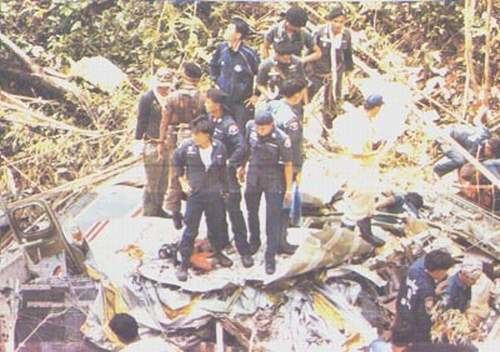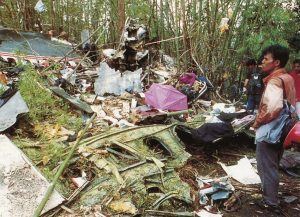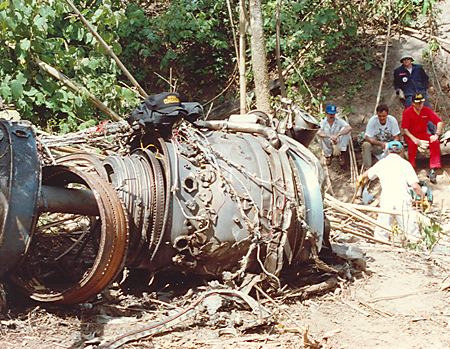Passengers 213 Survivors 0 Date 26 May 1991 Total fatalities 223 (all) Passenger count 213 | Crew 10 Survivor 0 | |
 | ||
Similar Kegworth air disaster, Varig Flight 254, Nigeria Airways Flight 2120, Copa Airlines Flight 201, Continental Express Flight 2574 | ||
Lauda air flight 004 crash animation
Lauda Air Flight 004 was a regurlarly-scheduled international passenger flight between Bangkok and Vienna. On 26 May 1991 a Boeing 767-300ER operating the flight crashed due to an uncommanded deployment of the thrust reverser on the No.1 engine in mid-flight, killing all 213 passengers and the 10 crew members on board. To date, it remains the deadliest aviation accident involving a Boeing 767 and the deadliest aviation accident in Thailand. The crash also marked the aircraft type's first fatal incident and first hull loss. Lauda Air was founded and run by the former Formula One world motor racing champion Niki Lauda. Lauda was personally involved in the accident investigation.
Contents
- Lauda air flight 004 crash animation
- Aircraft
- History of the flight
- Recovery
- Speculation
- Investigation
- Niki Laudas visit with Boeing
- Previous testing of thrust reversers
- Passengers and crew
- Notable victims
- Aftermath
- In popular culture
- References

Aircraft

The aircraft involved was a Boeing 767-300ER which had been delivered new to Lauda Air on 16 October 1989 and was only ever operated by them. It wore the manufacturing number MSN 24628, was registered as OE-LAV and was christened Mozart.
History of the flight

At the time of the accident, Lauda Air operated three weekly flights between Bangkok and Vienna. On 26 May 1991, at 23:02 local time, flight NG004 (originating from Hong Kong's Kai Tak Airport), a Boeing 767-3Z9ER, took off from Old Bangkok International Airport (Don Mueang International Airport) for its flight to Vienna International Airport with 213 passengers and 10 crew, under the command of Captain Thomas J. Welch of the United States and First Officer Josef Thurner of Austria.

At 23:08, Welch and Thurner received a visual warning indicating that a possible system failure would cause the thrust reverser on the number one engine to deploy in flight. Having consulted the aircraft's quick reference handbook, they determined that it was "just an advisory thing" and took no action.
At 23:17, the thrust reverser on the number one engine deployed while the plane was over mountainous jungle terrain in the border area between Suphanburi and Uthai Thani provinces in Thailand. Thurner's last recorded words were, "Oh, reverser's deployed." The lift on the aircraft's left side was disrupted due to the reverser deployment, and the aircraft was placed in an immediate diving left turn. The aircraft went into a diving speed of Mach 0.99, and may have broken the sound barrier. The aircraft broke up in mid-air on the way down at 4,000 feet (1,200 meters). Most of the wreckage was scattered over a remote forest area roughly 1 km2 in size, at an elevation of 600 m above sea level, in what is now Phu Toei National Park, Suphanburi. The wreckage site is about 6 kilometres (3 nmi) north northeast of Phu Toey, Huay Kamin, Dan Chang District, Suphan Buri Province, about 160 kilometres (100 mi) northwest of Bangkok, close to the Burma-Thailand border.

None of the 223 passengers and crew aboard the airliner survived. Rescuers found Welch's body still in the pilot's seat. After the accident, looters stole electronics and jewellery.
Recovery
Volunteer rescue teams and local villagers looted the remains of the flight, so relatives were unable to recover personal possessions. The bodies were taken to a hospital in Bangkok. The storage was not refrigerated and the bodies decomposed. Dental and forensic experts worked to identify bodies. Twenty-seven bodies were never identified.
Speculation
Speculation that a bomb may have destroyed the aircraft circulated. The Philadelphia Inquirer, citing wire services it did not identify, stated that, "the search for a motive is difficult because politically neutral Austria has generally stayed out of most international conflicts – such as the Persian Gulf war – that have made other countries' airlines the targets of terrorist attacks." According to a security officer working at an embassy of a Western country a Lauda Air employee stationed in Bangkok had threatened to use a bomb to destroy a Lauda aircraft unless he was given money. Lauda Air fired the employee but he was later hired by Thai Airways International, which handled luggage loading and uploading for Lauda Air in Bangkok. Niki Lauda, owner of the airline, said that the airline never received a threat.
Investigation
The flight data recorder was damaged to the point of being unreadable, so only the cockpit voice recorder was of use. Pradit Hoprasatsuk, the head of the Air Safety Division of the Thailand Department of Aviation, stated, "the attempt to determine why the reverser came on was hampered by the loss of the flight data recorder, which was destroyed in the crash". Upon hearing of the crash, Niki Lauda traveled to Thailand. He examined the wreckage and estimated that the largest fragment was about 5 metres (16 ft) by 2 metres (6.6 ft), which was about half the size of the largest piece in the Lockerbie crash. In Thailand, Lauda attended a funeral for 23 unidentified passengers, and then traveled to Seattle to meet with Boeing representatives.
The official investigation could not determine the cause of the thrust reverser deployment. Different possibilities were investigated, including a short circuit in the system. However, partly due to the destruction of much of the wiring, no definitive reason for the activation of the thrust reverser could be found.
As evidence started to point towards the thrust reversers as the cause of the accident, simulator flights were made at Gatwick Airport which appeared to show that deployment of a thrust reverser was a survivable incident. Lauda said that the thrust reverser could not be the sole cause of the crash. The accident report states that the "flightcrew training simulators yielded erroneous results" and stated that recovery from the loss of lift from the reverser deployment "was uncontrollable for an unexpecting flight crew". The incident led Boeing to modify the thrust reverser system to prevent similar occurrences by adding sync-locks, which prevent the thrust reversers from deploying when the main landing gear truck tilt angle is not at the ground position.
The aviation writer Macarthur Job has said that "had that Boeing 767 been of an earlier version of the type, fitted with engines that were controlled mechanically rather than electronically, then that accident could not have happened".
The investigation took about eight months.
Niki Lauda's visit with Boeing
Lauda said, "what really annoyed me was Boeing's reaction once the cause was clear. Boeing did not want to say anything." Lauda asked Boeing to fly the scenario in a simulator. Boeing initially refused, but Lauda insisted. Lauda attempted the flight in the simulator 15 times, and in every instance he was unable to recover. He asked Boeing to issue a statement, but the legal department said it could not be issued because it would take three months to adjust the wording. Lauda asked for a press conference the following day, and told Boeing that if it was possible to recover, he would be willing to fly on a 767 with two pilots and have the thrust reverser deploy in air. Boeing told Lauda that it was not possible, so he asked Boeing to issue a statement saying that it would not be survivable, and Boeing issued the statement. Lauda said, "this was the first time in eight months that it had been made clear that the manufacturer was at fault and not the operator of the aeroplane."
Previous testing of thrust reversers
When the Federal Aviation Administration (FAA) of the United States asked Boeing to do tests activating the thrust reverser in flight, the FAA had allowed Boeing to establish the tests of the thrust reverser. Boeing had insisted that a deployment was not possible in flight. In 1982 Boeing established a test where the aircraft was slowed to 250 knots, and the test pilots then used the thrust reverser. The control of the aircraft had not been jeopardized. The FAA accepted the results of the test.
The Lauda aircraft was traveling at a high speed when the thrust reversers deployed, causing the pilots to lose control of the aircraft. James R. Chiles, author of Inviting Disaster, said, "the point here is not that a thorough test would have told the pilots Thomas J. Welch and Josef Thumer [sic] what to do. A thrust reverser deploying in flight might not have been survivable, anyway. But a thorough test would have informed the FAA and Boeing that thrust reversers deploying in midair was such a dangerous occurrence that Boeing needed to install a positive lock that would prevent such an event." As a result of their findings during the investigation process of Lauda Flight 004, additional safety features such as mechanical positive locks were mandated to prevent thrust reverser deployment in flight.
Passengers and crew
The passengers and crew included 83 Austrians: 74 Austrian passengers and nine Austrian crew members. 52 Hong Kong residents were on board the aircraft. Other nationalities included Thais (39), Italians (10), Swiss (7), Chinese (6), Germans (4), Portuguese (3), Taiwanese (3), Yugoslavs (3), Hungarians (2), Filipinos (2), Britons (2), Americans (2), Australian (1), Brazilian (1), Polish (1), and Turkish (1). In addition, an American was the aircraft's pilot.
Of the passengers, 125 had boarded in Hong Kong, while the rest boarded in Bangkok. Of the passengers who boarded in Bangkok, there were 38 Thais, 34 Austrians, seven Swiss, four Germans, two Yugoslavs, one Australian, one Briton, and one Hungarian. Of the passengers who boarded in Hong Kong, most were either Austrian or Chinese.
Of the passengers, 10 were from South Tyrol in Italy. Six of them were students of the University of Innsbruck School of Economics, and they originated from Val Gardena (Gröden), Kiens (Chienes), Klausen (Chiusa), Mals (Malles Venosta), and Olang (Valdaora). The other four were from Bolzano (Bozen), including two public officers, a musician, and his daughter. The musician was traveling with his Chinese wife.
Notable victims
Josef Thurner, the copilot, once flew as a copilot with Niki Lauda on a Lauda Boeing 737 service to Bangkok, a flight that was the subject of a Reader's Digest article in January 1990 that depicted the airline positively. Macarthur Job said that, as a result, Thurner was the better known of the crew members. Thomas J. Welch, the pilot, lived in Vienna, but originated from Seattle, Washington.
Aftermath
About one quarter of the airline's carrying capacity was destroyed as a result of the crash. Following the crash of OE-LAV, the airline had no flights to Sydney, on 1, 6, and 7 June. Flights resumed with another 767 on 13 June. Niki Lauda said that the crash in 1991 and the period after was the worst time in his life.
In early August 1991, Boeing issued an alert to airlines stating that over 1,600 late model 737s, 757s, 767s, and 747s had thrust-reverser systems common to that of the OE-LAV. On Monday, 9 September 1991, the Boeing Commercial Airplane Group asked its customers to replace a valve in the thrust reverser systems that could cause the thrust reverser to deploy in flight.
After the crash, bookings from Hong Kong decreased by 20% but additional passengers from Vienna began booking flights, so there were no significant changes in overall bookings.
Fourteen months before 25 May 1993, Boeing and Lauda Air came to a joint settlement with most of the families of the deceased victims, but by 25 May 1993, 20 families that had children as claimants had not yet received settlement money. The law firm Sinclair Roche represented almost all of the relatives of the Hong Kong residents who died in the crash.
At the crash site, which is accessible to national park visitors, a shrine was later erected to commemorate the victims. Another memorial and cemetery is located at Wat Sa Kaeo Srisanpetch – GPS location: 14.492145, 100.001884, some 90 km away in Amphoe Mueang Suphanburi.
